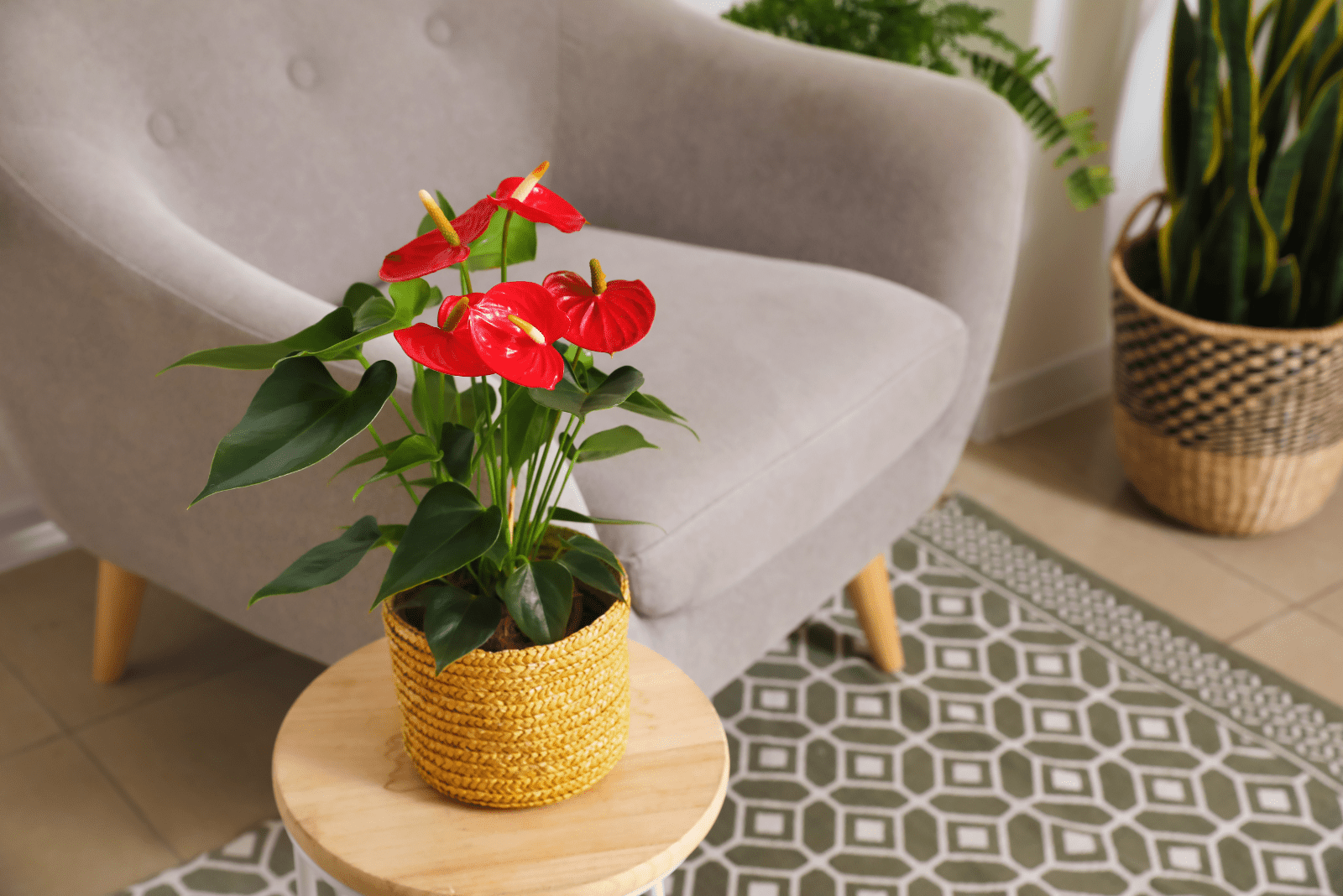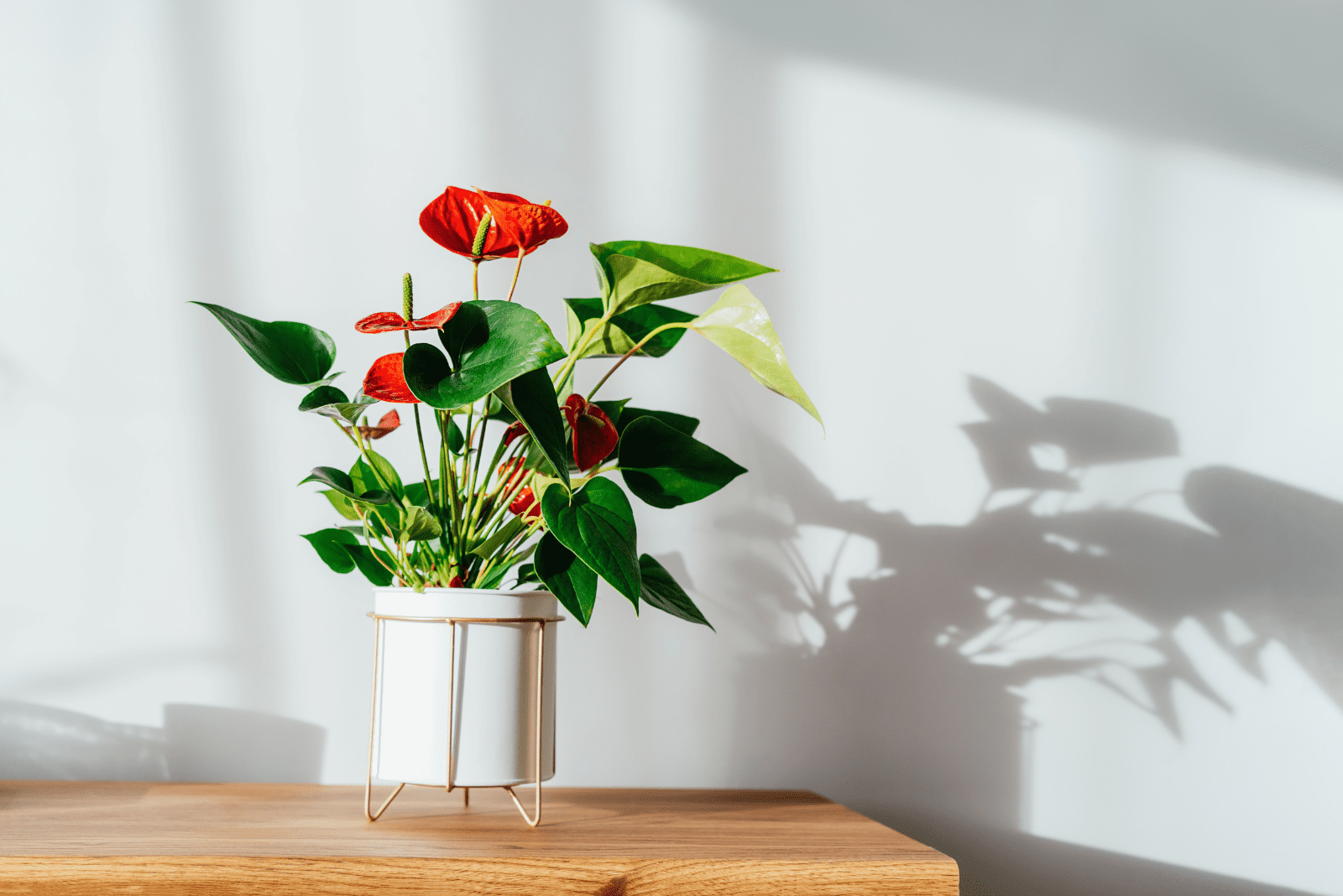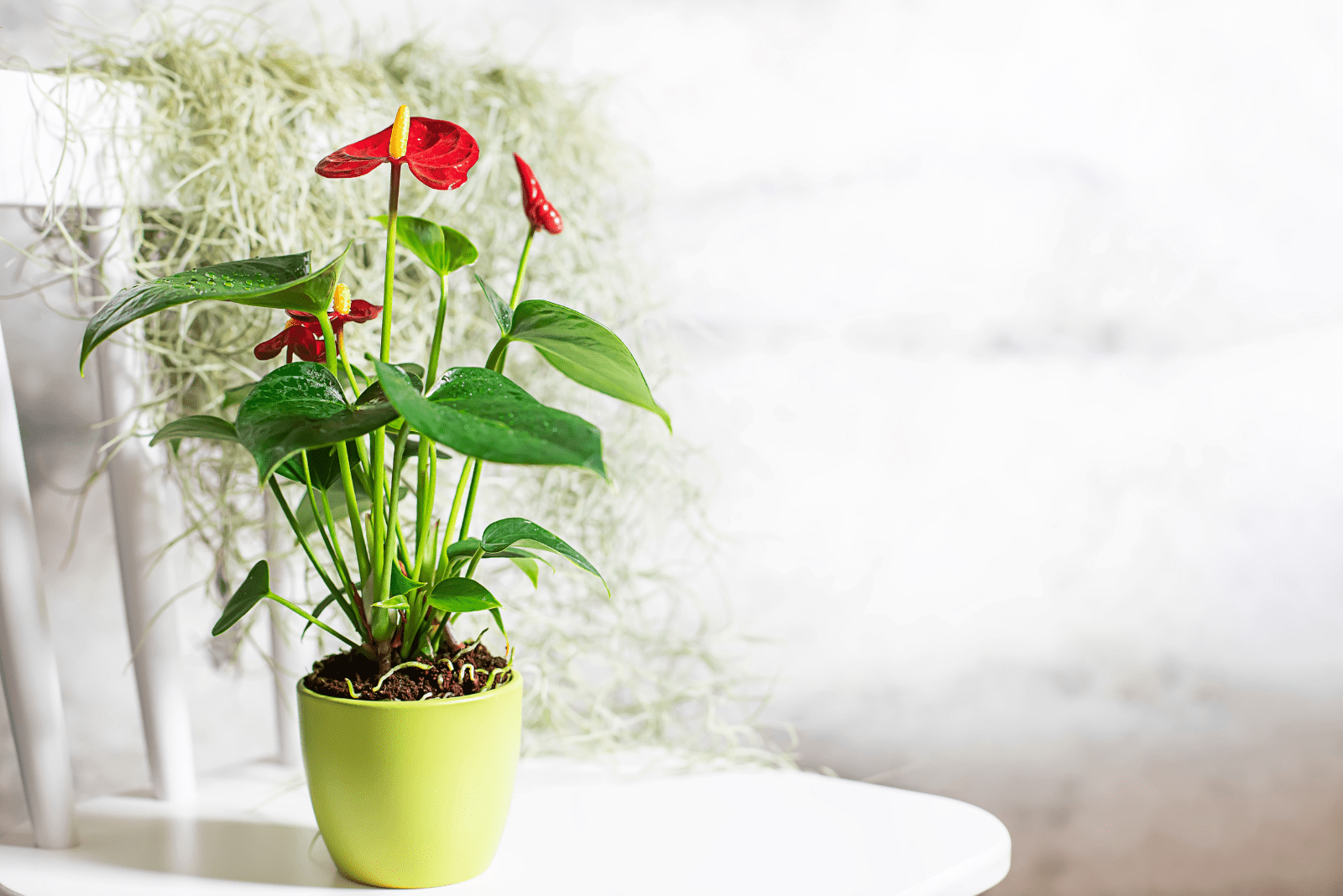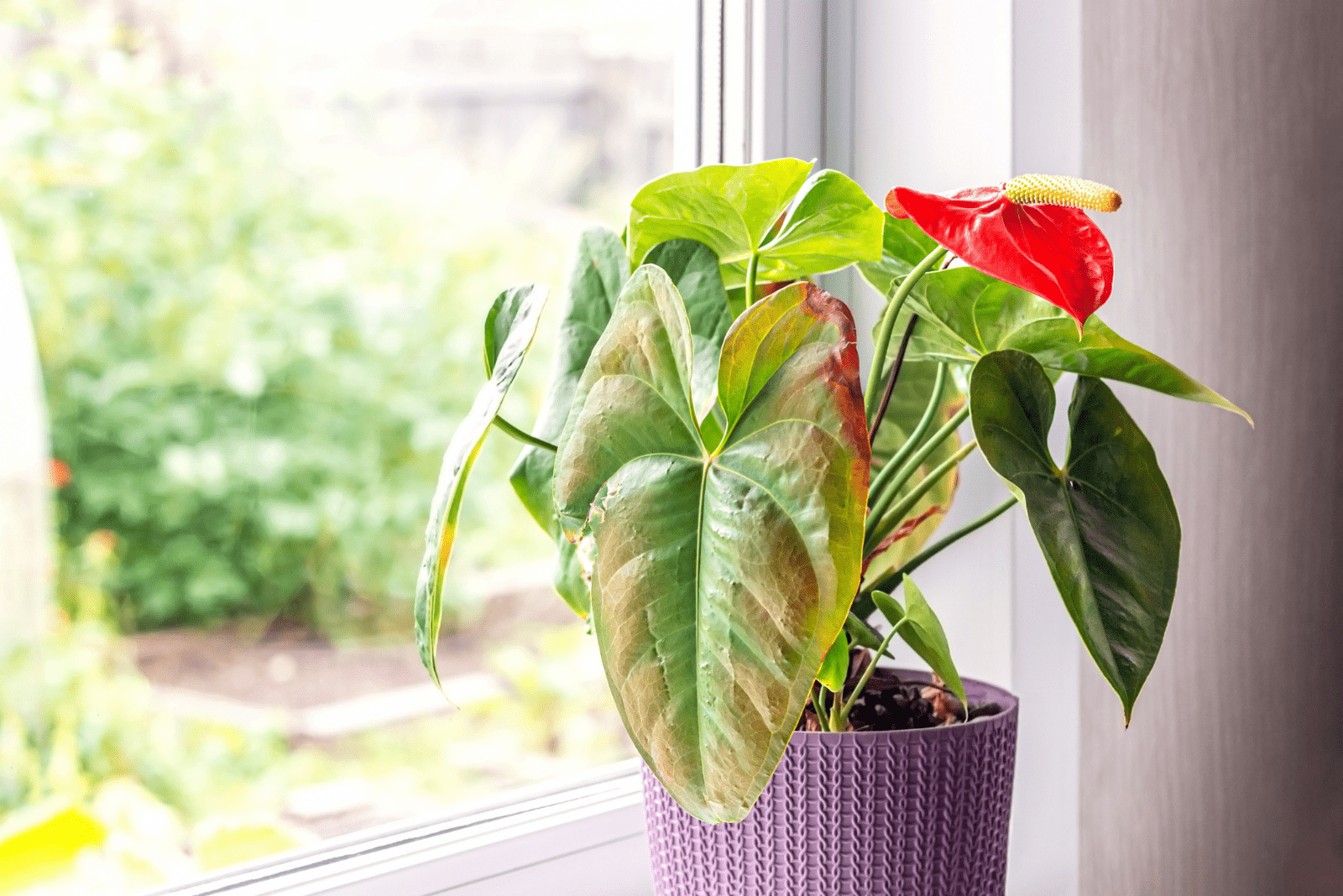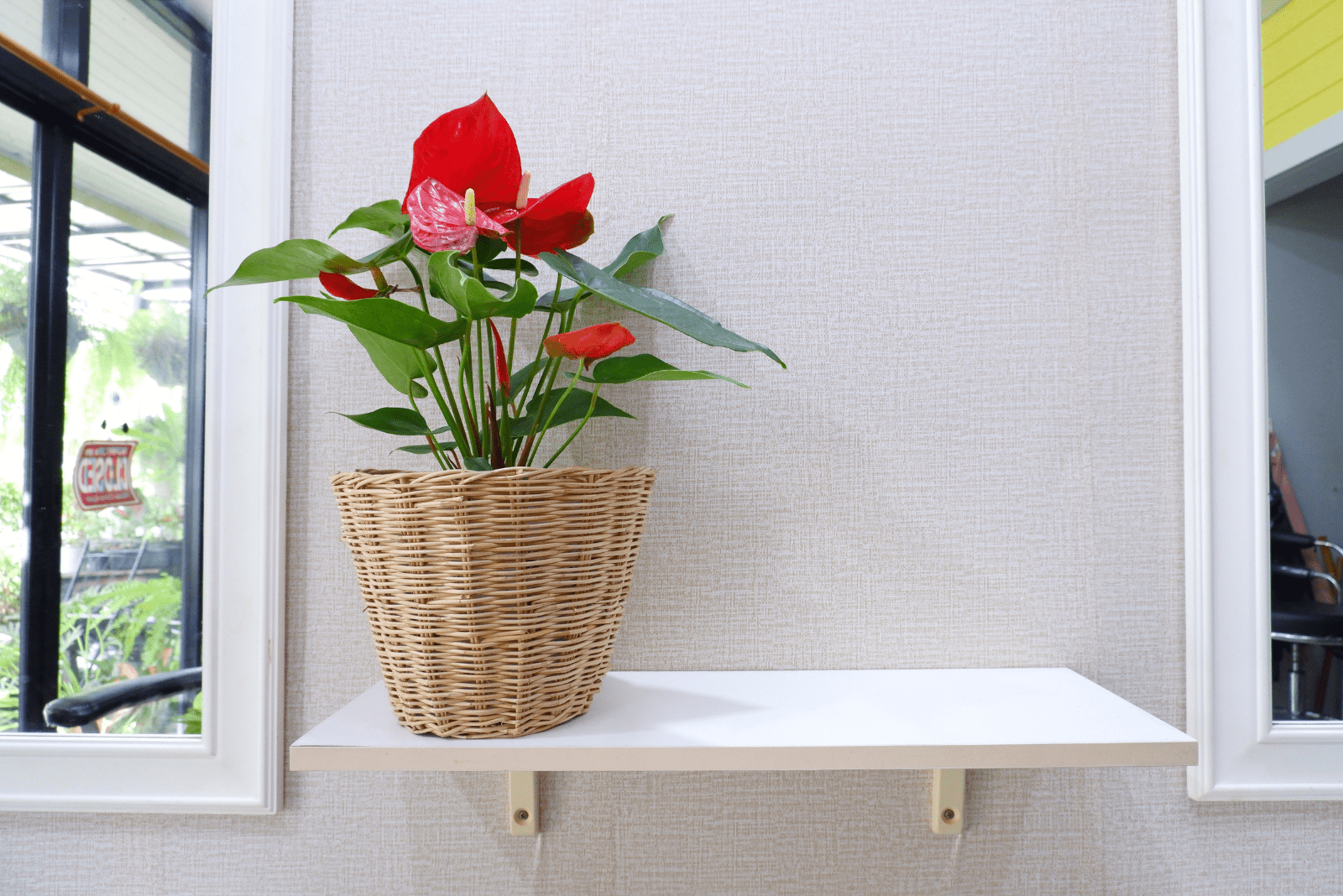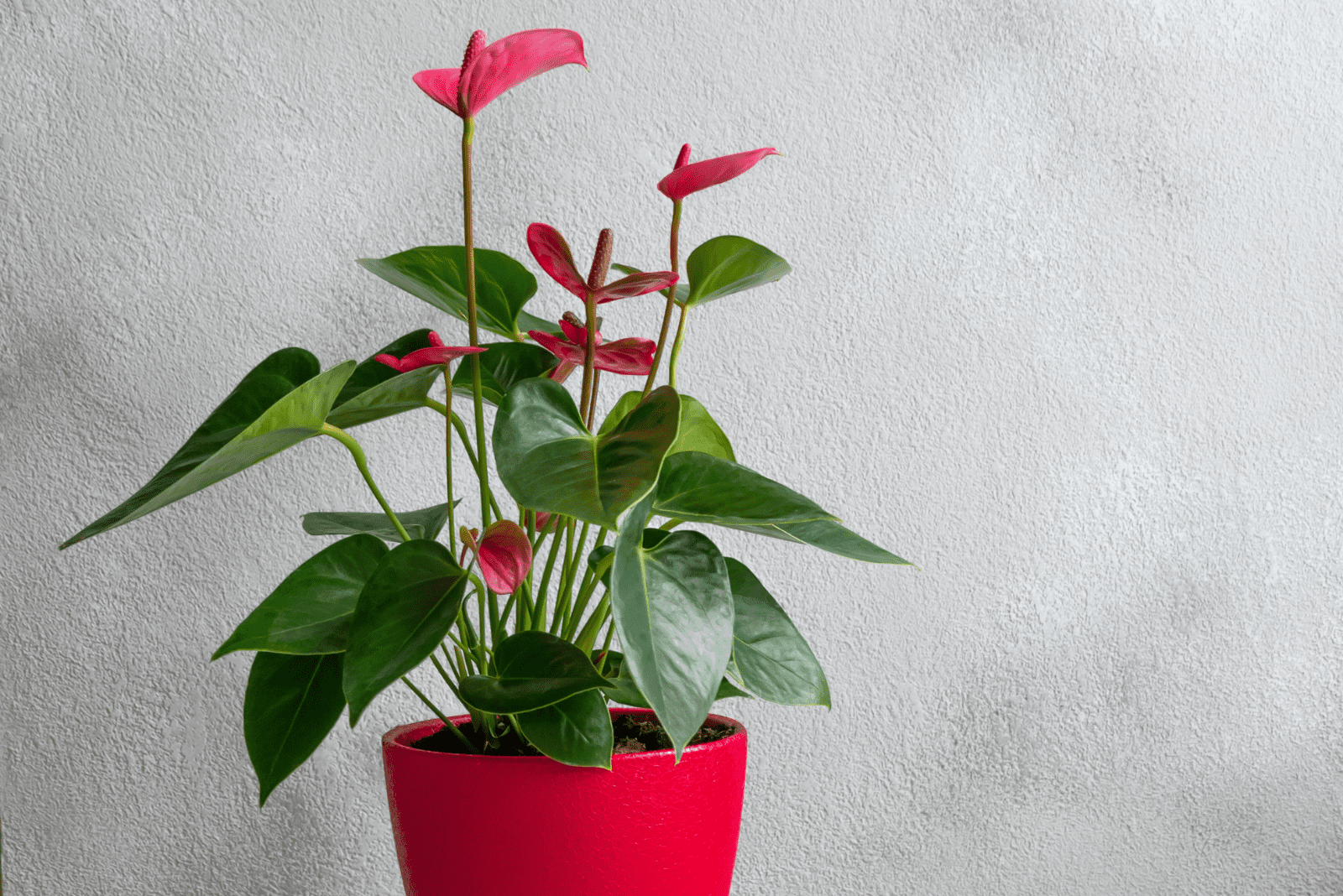If you are looking for unique exotic plants, I highly recommend choosing species from the Anthurium genus.
Many growers claim that Anthurium plants can be fussy about care requirements. That may be true, but once you select a good location, your Anthurium is destined to thrive.
It’s essential to know about Anthurium light requirements, including what type and how much light this plant really needs.
In this article, I’ll tell you more about perfect light conditions and where to place these plants. You’ll also learn when you need to lower or increase light levels, as well as more tips on Anthurium care.
Let’s get started!
Anthurium Light Requirements: Perfect Light Level
Anthuriums need a lot of light to flourish, but they can be picky about how they receive it.
Finding a spot where your Anthurium will get enough light may be pretty challenging. They’ll be stressed if they don’t receive enough light, but will also suffer if you give them too much.
These are tropical plants, which is one of the reasons why many beginner growers think that these plants thrive in full sun.
The truth is that these plants grow under the rainforest canopy in their natural habitat, which means they don’t receive direct light.
So, are these low-light plants then?
Although flamingo flowers dislike being directly in the sun, they do enjoy absorbing a lot of photons throughout the day. Therefore, Anthuriums need bright indirect light.
This term often confuses growers, which is why we first need to resolve the confusion between direct and indirect light.
Direct vs Indirect Light
What does direct sunlight mean for plants? When plants are fully exposed to direct sun, and nothing blocks intense sun rays, plants receive direct light.
Anthurium plants grow under tall trees, and sun rays bounce off or go through the leaves of taller plants before reaching the Anthurium leaves. This means the light is filtered, so these plants receive bright indirect sunlight.
What is the best way to check the light level in your room? I highly recommend using light meters! These useful tools will provide you with an accurate light level in foot candles (metric).
If the device reads from 1,000 to 2,000 foot-candles, you are good to go; it’s bright indirect light and perfect for your Anthurium.
Where To Place Your Anthurium Plant
You’ve found out what type of light is perfect for your Anthurium. However, you can think of it as a more general recommendation, not a strict rule. It’s not that easy to kill some plants, particularly Anthuriums.
Shorter periods of direct sun exposure won’t burn your plant. Still, it can’t withstand the full sun if the exposure is prolonged.
When discussing Anthurium light tolerance, I have to mention that the light level for the flamingo flower plant depends on many variables, such as temperature, humidity, season, and time of the day.
For example, if your Anthurium receives direct light in the morning, it won’t be harmful because the sun isn’t as intense then. The problem is the afternoon sun, which houseplants aren’t fans of.
Perfect Spot
We place our plants on or near windows so that they can receive enough light, but you can’t place your Anthurium near just any window.
South-facing Window
Before placing your laceleaf plant near a south-facing window, you need to know a few things.
First, these windows receive the most direct sun during the day, so placing an Anthurium in one would likely burn your Anthurium.
You should consider south-facing windows only if you have a room big enough to keep your Anthurium 4-6 feet from the window.
This distance will ensure protection from the intense sun, but your plant will still receive the light it needs.
West-facing Window
Now let’s discuss the west-facing window. If you plan to place your Anthurium near this window, you need to know that even though the direct light exposure is lower, it’s still too high for your laceleaf plant.
The problem is the combination of sun intensity and high temperatures in the afternoon. This combination is detrimental for Anthurium plants.
Again, you can consider a west-facing window if your room is big enough for the plant to be kept 3-4 feet away from the window.
North-facing Window
North-facing windows only receive indirect sunlight. However, these windows lack bright light, which means they aren’t the best choice for your Anthuriums.
Laceleaf plants may tolerate this type of exposure during summer, but I wouldn’t risk it.
East-facing Window
An east-facing window is definitely the best choice for Anthurium plants.
It will provide your plant with direct sunlight during the coldest parts of the day, and indirect light during the warmest parts of the day.
Trust me; your laceleaf plant will love you if you put it in front of or near one of these windows!
Temperature And Light
Dehydration is the most common consequence of too much light exposure in Anthuriums. It causes the transpiration rate to increase, which means the leaves lose water faster.
Once they run out of water, their cells collapse and the heart-shaped leaves start turning yellow. They also become crispy and display brown blotches.
If you live in a colder climate, you can give your Anthurium more light than recommended.
Be careful with heating vents; Anthuriums can’t withstand dry and hot air from heating sources, or temperatures exceeding 90 degrees in any situation.
If these houseplants receive more light, their temperature tolerance changes and 90 degrees will be detrimental.
Humidity And Light
Laceleaf plants need a humidity level of at least 50%, which is higher than typical household humidity.
First, you need to check the humidity level in the room where your Anthurium grows. You can use a hygrometer to get precise results. If the humidity is below 50% (which I assume it is), you’ll need to raise it.
The most effective way to raise humidity levels is with a humidifier. You can purchase a smaller, cheaper type, and simply place it near your indoor plants.
There are also more powerful humidifiers on the market that can control humidity levels.
It’s important to note that you don’t need to increase humidity in your entire house, just in the area surrounding your Anthurium.
Some growers mist their plants regularly. Although this is less effective than a humidifier, over time, you’ll develop a sense of how frequently you should spray your Anthuriums.
One more inexpensive and easy solution is a pebble tray; just add pebbles, gravel, or marbles to a shallow dish and pour fresh water over them.
You can also group your plants; if you grow different Anthurium species, such as Anthurium chamberlainii, Anthurium radicans, or Anthurium balaoanum, place them near each other and they can mutually benefit from transpiration to raise humidity.
Other plants from the Araceae family, such as pothos, can also be placed next to laceleaf plants.
How To Tell If Your Anthurium Is Getting Too Much Light
It can be tricky to determine if your plants are receiving too much or not enough light. In Anthuriums, there are a few sure signs they’re getting too much light.
These plants display pale yellow leaves and frequently have brown or white spots due to decayed tissue. If there are flowers, they’ll most likely fade and wither. Growers call this leaf or sun scorch.
Keep in mind that brown and yellow leaves are signs of dryness, which can be brought on by reasons other than sunlight.
Overwatering, underwatering, and overfertilization all cause discoloration, so you need to inspect your Anthurium closer just to be sure. Brown tips on Anthurium leaves occur if your plant is exposed to cold drafts or temperature fluctuations.
You can tell that your flamingo flower plant is receiving too much light if the leaves on top of the plant suffer from sunburns. If the side of the plant that faces the window has sunburned leaves, the light level is likely the problem.
If your Anthurium gets more light than it needs, its potting soil will be dry and the leaves may also curl. You may even notice wilting, especially during the intense afternoon sun.
What To Do
Fortunately, your laceleaf plant will recover soon after relocating to a shady spot. To reduce stress over the following couple of weeks, place your flamingo flower somewhere it won’t receive direct light, but don’t put it in a completely dark corner as it will have the opposite effect.
Unless the damaged leaves are completely dead, they do not need to be removed. The parts that are unharmed can still absorb energy to support the plant in producing fresh, healthy leaves.
However, you might want to remove any spathes (the scientific name for the vibrant blossoms of the flamingo flower), because they use up more resources than regular leaves do.
When a plant is healing from sunburn, watering and feeding should be reduced until all of the leaves have recovered.
How To Filter The Light
Anthuriums can also be shielded from direct sunlight by blocking some of the light. If you hang some sheer curtains to diffuse the sun rays in a room with large, south-facing windows, for example, your beautiful plants can still thrive there.
This results in a light that is bright, but filtered, more like the light these plants would get in the higher elevations of the jungle.
This can be accomplished using a variety of lightweight materials, such as polyester, chiffon, and linen.
You could also put a UV-blocking window film on the glass. In the summer, these simple-to-apply films filter out up to 85% of the heat from sunlight, which makes the surroundings for indoor plants more comfortable. Additionally, they can reduce the amount of energy needed to heat and cool your house.
Another excellent choice is to use partially-open Venetian blinds to ensure that most sunlight will enter the room by reflecting off the lower parts of the slats.
How To Know If Your Anthurium Needs More Light
The symptoms of a lack of light are milder than those of sunburn. These plants have a slow to moderate growth rate, and if they grow in low light conditions, the growth rate will decrease.
Additionally, you won’t notice any new growth and your Anthurium won’t bloom. Although it’s not dead, it’s not having a good time either.
Another sure sign of a lack of light is the color of the spathes. They are normally vivid red, but in poor light conditions they turn pale green.
Remember that light is closely connected to water evaporation from the soil; if the light is too low, water evaporates too slowly and it becomes easier to overwater your Anthurium, which may lead to root rot.
What To Do
Moving your plant to a spot with more light is the simplest solution in this situation. For example, if your Anthurium grows in a room with northern-direction exposure, just move it to an east-facing room a little closer to the windows.
However, the best idea would be to make the transition gradually to avoid stressing your flamingo flower plant.
For instance, you can start by giving the plant about an hour or so of direct sun in the morning and increase the time spent in direct sunlight every day.
If your laceleaf plant is already in the room with the biggest amount of sunlight in your house, and still shows signs of lack of light, it’s time to use artificial lights.
Can Artificial Lights Burn Your Anthurium Plants?
The answer is yes and no; the type of bulb, as well as the strength, determines the outcome.
I use LED lights and I haven’t had any issues. These energy-saving lights produce very little heat, so you can put them pretty close to your flamingo flower plant without risking damage.
For example, if your laceleaf plants receive direct sunlight for a couple of hours, which doesn’t seem like enough, then approximately 6 hours of LED light exposure should do the job.
On the other hand, if your Anthurium grows in low light conditions, a minimum of 12 hours of LED exposure will be needed.
The key to ensuring enough light for Anthuriums is actually in performing regular inspections. If you pay attention to the plant’s growth rate and overall health, you won’t have issues determining if the plant lacks or receives enough light.
Of course, all other factors of plant care should be considered and checked if your plant shows any signs of stress.
FAQs
What is the best way to care for an anthurium?
Proper care for Anthurium plants includes ensuring enough light, proper temperatures and humidity levels, suitable soil, and maintaining a proper watering and fertilizing schedule.
Laceleaf plants require bright indirect light, so placing them near east-facing windows is the best you can do. Use sheer curtains to filter direct sunlight or grow lights if your Anthurium lacks light.
The ideal temperature range for flamingo flower plants is from 65 to 85 degrees Fahrenheit.
Humidity should be over 50% for your Anthurium to thrive. These plants are extremely sensitive to temperature fluctuations and cold drafts; you should aim for spots far away from heating sources and air conditioners.
These plants thrive in well-draining and porous potting soil; I recommend potting mix for orchids amended with perlite and gardening sand.
Keep the Anthurium soil moist and water when the top 2 inches dry out. Feed your flamingo flower weekly during the growing season with liquid fertilizer rich in phosphorus to promote flowering.
Once your laceleaf plant outgrows its pot, you should repot it.
What color is an anthurium?
The color of an Anthurium depends on the species. For example, the most common variety, Anthurium andreanum, comes in pink, red, white, and variegated colors. The Anthurium scherzerianum has orange flower spikes, and the A. luxurians produces dark red to purple leaves.
These amazing tropical plants come in various colors, making them perfect houseplants and a great addition to any plant collection.
Wrapping Up
Anthuriums are truly unique plants, and they come in various colors and shapes, making them even more desirable. They are especially well-liked as they produce flowers even when grown as houseplants, which is pretty rare for tropical plants.
These plants thrive when you provide them with conditions similar to their native habitats.
It’s essential to know the Anthurium light requirements because both insufficient and too much light affects the shape and color of these amazing plants.
Of course, all other aspects of flamingo flower plant care should be considered, but without light, these plants can’t thrive.
Take good care of your laceleaf plants, and they’ll reward you with stunning leaves and flowers, whose beauty, in my humble opinion, is incomparable.
Until next time!
Like this post? Share or pin it for later!

